Abstract
1. Rats given an intravenous injection of Sephadex particles (0.5 mg of G200 in 1 ml of saline) on days 0, 2 and 5 had a blood eosinophilia which was maximal on day 7. 2. On day 7, broncho-alveolar lavage (BAL) fluids taken from the rats contained an increased number of eosinophils and fewer mononuclear cells but there was no change in the small number of neutrophils. In addition the rats were hyper-sensitive to the increase in resistance to artificial respiration produced by 5-hydroxytryptamine (5-HT), given intravenously, with a shift to the left of the log dose-response curve. Lung parenchymal strips, taken from the rats on days 6, 7 and 8, were hyper-reactive to 5-HT with an increase in slope of the log dose-response curve. 3. Compounds with a wide variety of activities were evaluated for their effects on the blood eosinophilia on day 7 when given before each injection of Sephadex. The eosinophilia was reduced by glucocorticosteroids, beta-adrenoceptor agonists, aminophylline, dapsone and phenidone. 4. Dexamethasone, isoprenaline, dapsone and phenidone at doses that reduced the blood eosinophilia also reduced the changes in number of leucocytes in the BAL fluids and the hyper-responsiveness to 5-HT in vivo and in vitro, except that the effects of dapsone on the hyper-sensitivity to 5-HT in vivo did not reach significance. Aminophylline was the least effective of the drugs at reducing the blood eosinophilia and its effects on the other changes did not reach significance. Sodium cromoglycate reduced the BAL eosinophilia but had no effect on the other changes produced by Sephadex.(ABSTRACT TRUNCATED AT 250 WORDS)
Full text
PDF
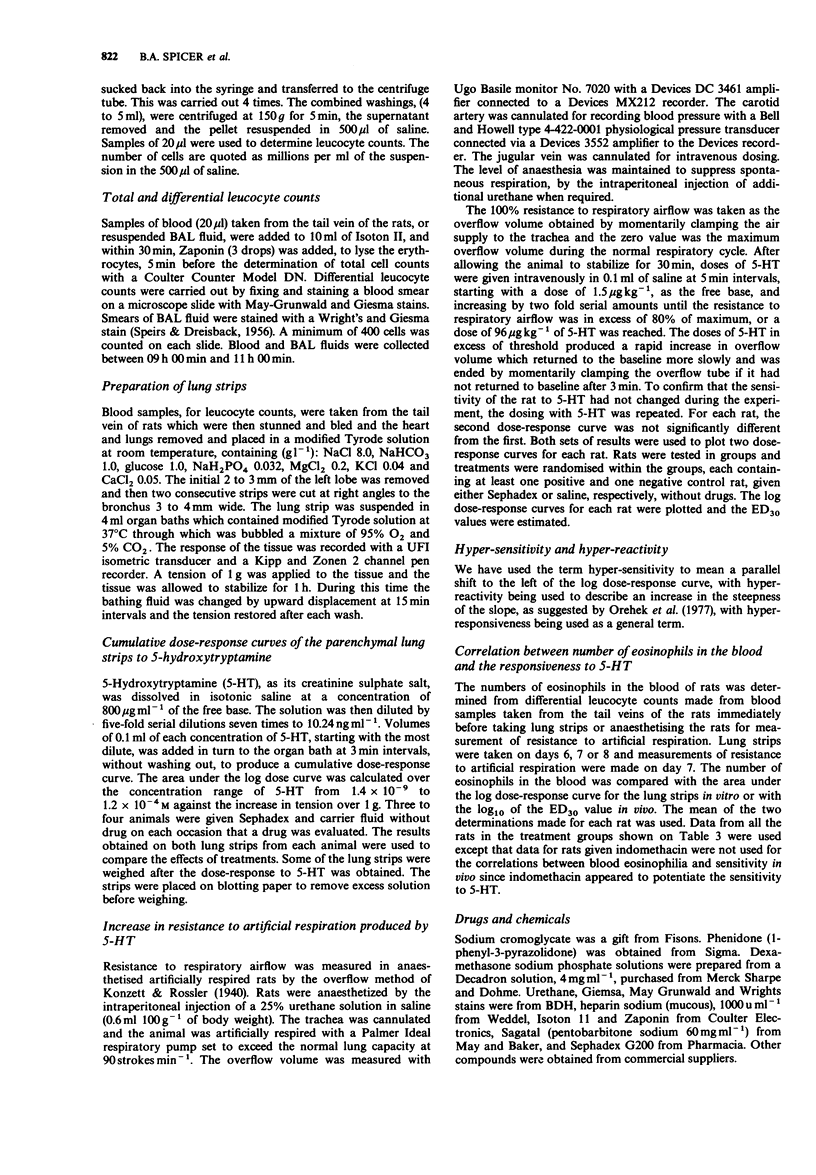

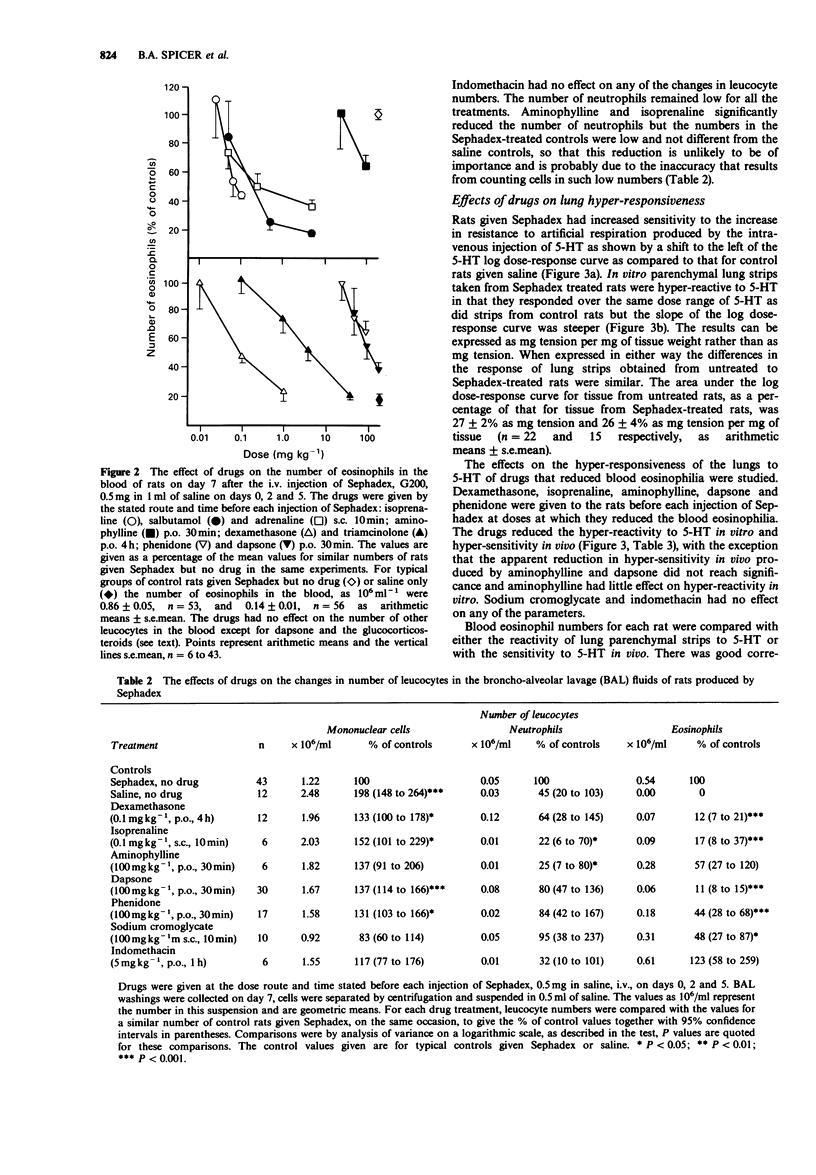
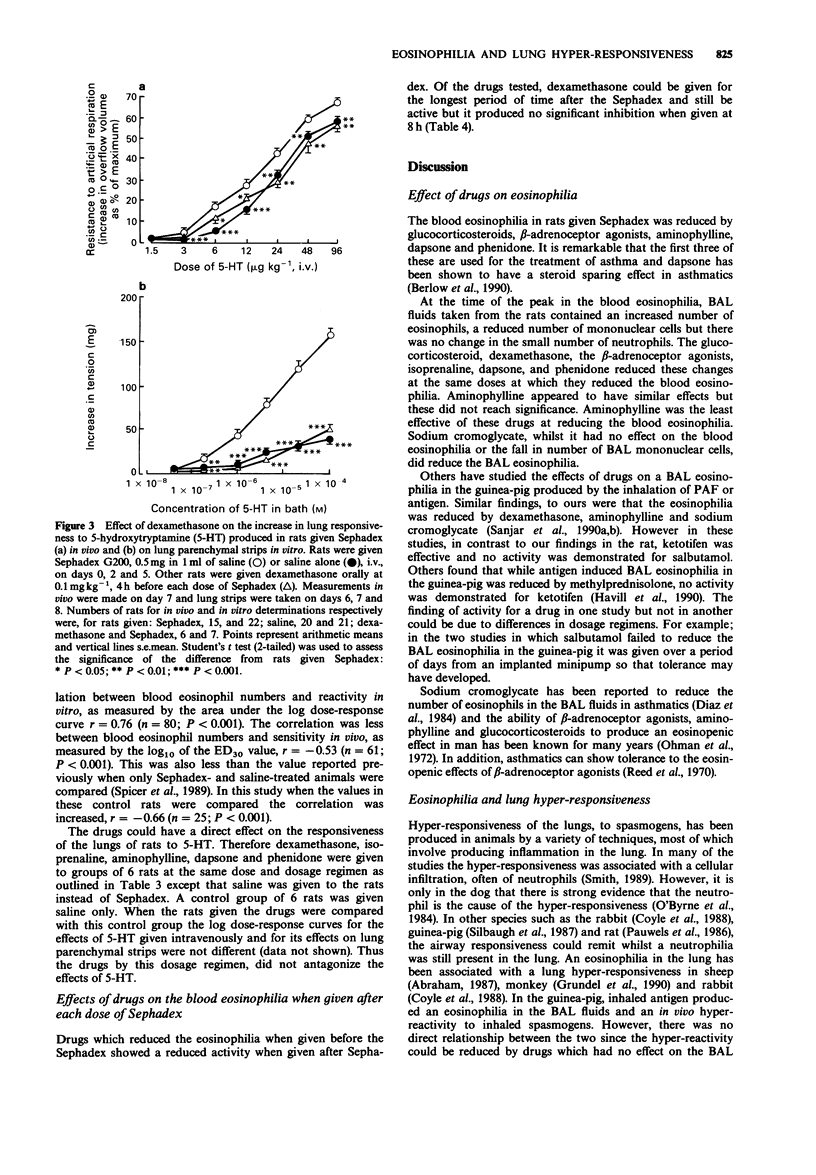
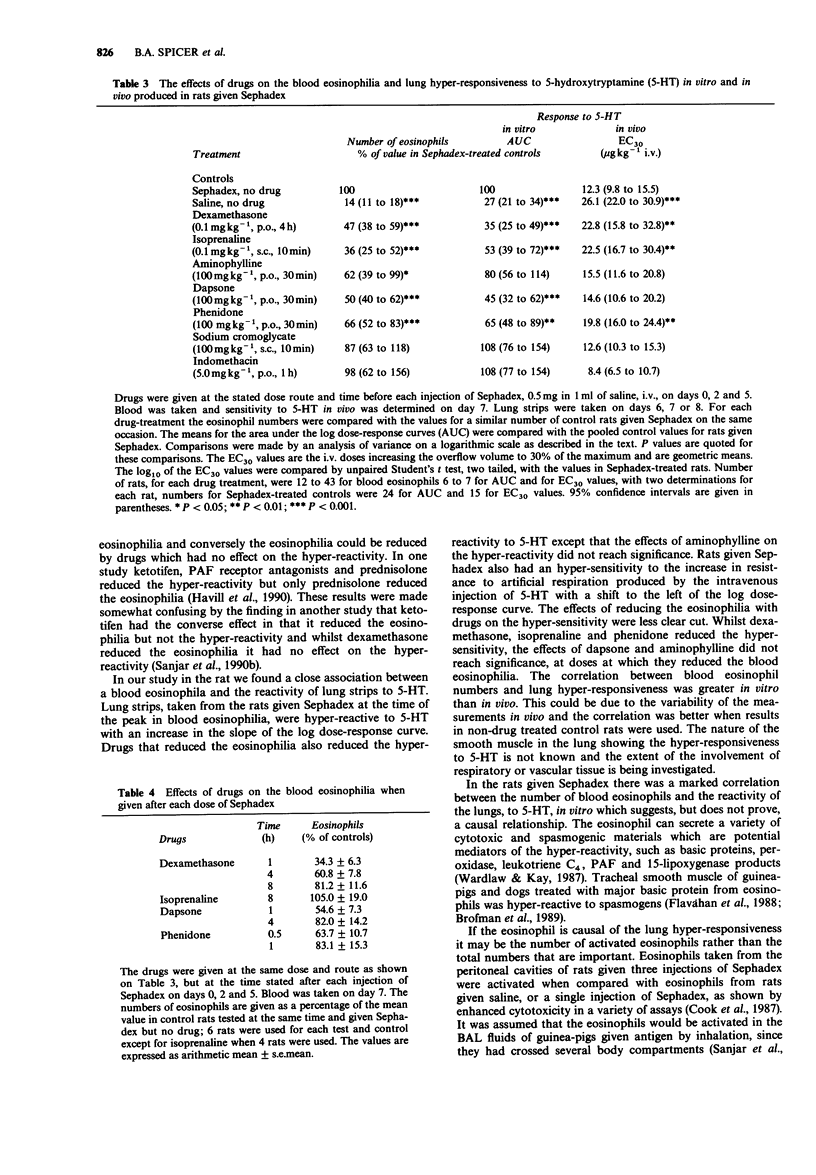
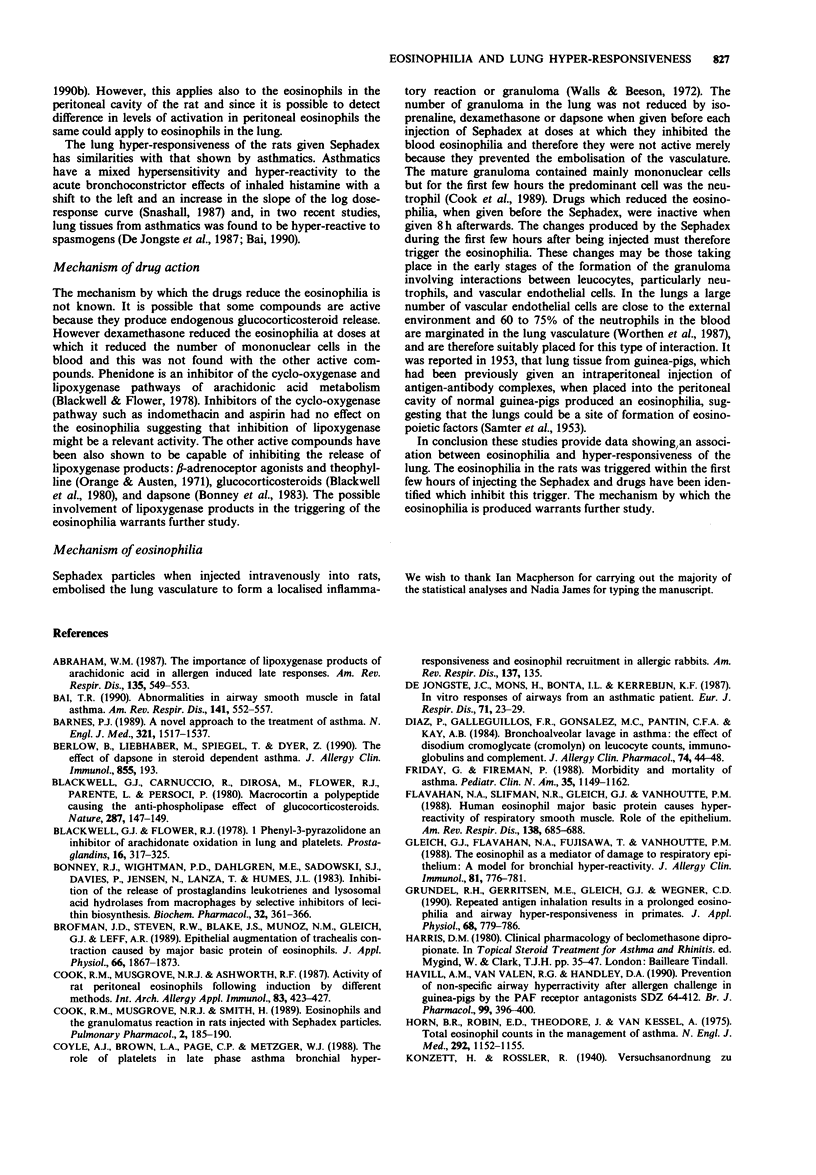
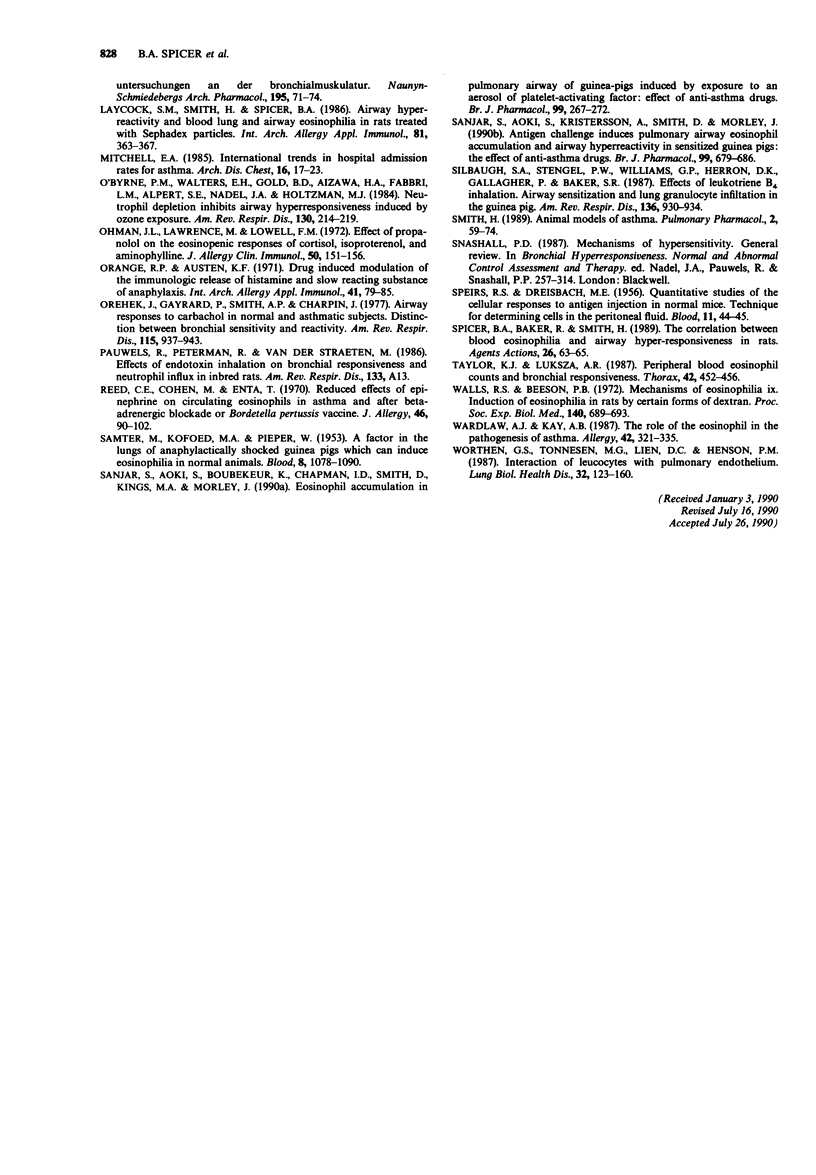
Selected References
These references are in PubMed. This may not be the complete list of references from this article.
- Bai T. R. Abnormalities in airway smooth muscle in fatal asthma. Am Rev Respir Dis. 1990 Mar;141(3):552–557. doi: 10.1164/ajrccm/141.3.552. [DOI] [PubMed] [Google Scholar]
- Barnes P. J. A new approach to the treatment of asthma. N Engl J Med. 1989 Nov 30;321(22):1517–1527. doi: 10.1056/NEJM198911303212206. [DOI] [PubMed] [Google Scholar]
- Blackwell G. J., Carnuccio R., Di Rosa M., Flower R. J., Parente L., Persico P. Macrocortin: a polypeptide causing the anti-phospholipase effect of glucocorticoids. Nature. 1980 Sep 11;287(5778):147–149. doi: 10.1038/287147a0. [DOI] [PubMed] [Google Scholar]
- Bonney R. J., Wightman P. D., Dahlgren M. E., Sadowski S. J., Davies P., Jensen N., Lanza T., Humes J. L. Inhibition of the release of prostaglandins, leukotrienes and lysosomal acid hydrolases from macrophages by selective inhibitors of lecithin biosynthesis. Biochem Pharmacol. 1983 Jan 15;32(2):361–366. doi: 10.1016/0006-2952(83)90568-3. [DOI] [PubMed] [Google Scholar]
- Brofman J. D., White S. R., Blake J. S., Munoz N. M., Gleich G. J., Leff A. R. Epithelial augmentation of trachealis contraction caused by major basic protein of eosinophils. J Appl Physiol (1985) 1989 Apr;66(4):1867–1873. doi: 10.1152/jappl.1989.66.4.1867. [DOI] [PubMed] [Google Scholar]
- Cook R. M., Musgrove N. R., Ashworth R. F. Activity of rat peritoneal eosinophils following induction by different methods. Int Arch Allergy Appl Immunol. 1987;83(4):423–427. doi: 10.1159/000234379. [DOI] [PubMed] [Google Scholar]
- Cook R. M., Musgrove N. R., Smith H. Eosinophils and the granulomatous reaction in rats injected with Sephadex particles. Pulm Pharmacol. 1989;2(4):185–190. doi: 10.1016/0952-0600(89)90019-7. [DOI] [PubMed] [Google Scholar]
- De Jongste J. C., Mons H., Block R., Bonta I. L., Frederiksz A. P., Kerrebijn K. F. Increased in vitro histamine responses in human small airways smooth muscle from patients with chronic obstructive pulmonary disease. Am Rev Respir Dis. 1987 Mar;135(3):549–553. doi: 10.1164/arrd.1987.135.3.549. [DOI] [PubMed] [Google Scholar]
- Flavahan N. A., Slifman N. R., Gleich G. J., Vanhoutte P. M. Human eosinophil major basic protein causes hyperreactivity of respiratory smooth muscle. Role of the epithelium. Am Rev Respir Dis. 1988 Sep;138(3):685–688. doi: 10.1164/ajrccm/138.3.685. [DOI] [PubMed] [Google Scholar]
- Friday G. A., Fireman P. Morbidity and mortality of asthma. Pediatr Clin North Am. 1988 Oct;35(5):1149–1162. doi: 10.1016/s0031-3955(16)36554-3. [DOI] [PubMed] [Google Scholar]
- Gleich G. J., Flavahan N. A., Fujisawa T., Vanhoutte P. M. The eosinophil as a mediator of damage to respiratory epithelium: a model for bronchial hyperreactivity. J Allergy Clin Immunol. 1988 May;81(5 Pt 1):776–781. doi: 10.1016/0091-6749(88)90931-1. [DOI] [PubMed] [Google Scholar]
- Gundel R. H., Gerritsen M. E., Gleich G. J., Wegner C. D. Repeated antigen inhalation results in a prolonged airway eosinophilia and airway hyperresponsiveness in primates. J Appl Physiol (1985) 1990 Feb;68(2):779–786. doi: 10.1152/jappl.1990.68.2.779. [DOI] [PubMed] [Google Scholar]
- Havill A. M., Van Valen R. G., Handley D. A. Prevention of non-specific airway hyperreactivity after allergen challenge in guinea-pigs by the PAF receptor antagonist SDZ 64-412. Br J Pharmacol. 1990 Feb;99(2):396–400. doi: 10.1111/j.1476-5381.1990.tb14715.x. [DOI] [PMC free article] [PubMed] [Google Scholar]
- Horn B. R., Robin E. D., Theodore J., Van Kessel A. Total eosinophil counts in the management of bronchial asthma. N Engl J Med. 1975 May 29;292(22):1152–1155. doi: 10.1056/NEJM197505292922204. [DOI] [PubMed] [Google Scholar]
- Laycock S. M., Smith H., Spicer B. A. Airway hyper-reactivity and blood, lung and airway eosinophilia in rats treated with Sephadex particles. Int Arch Allergy Appl Immunol. 1986;81(4):363–367. doi: 10.1159/000234164. [DOI] [PubMed] [Google Scholar]
- O'Byrne P. M., Walters E. H., Gold B. D., Aizawa H. A., Fabbri L. M., Alpert S. E., Nadel J. A., Holtzman M. J. Neutrophil depletion inhibits airway hyperresponsiveness induced by ozone exposure. Am Rev Respir Dis. 1984 Aug;130(2):214–219. doi: 10.1164/arrd.1984.130.2.214. [DOI] [PubMed] [Google Scholar]
- Ohman J. L., Jr, Lawrence M., Lowell F. C. Effect of propranolol on the isoproterenol, responses of cortisol, isoproterenol, and aminophylline. J Allergy Clin Immunol. 1972 Sep;50(3):151–156. doi: 10.1016/0091-6749(72)90046-2. [DOI] [PubMed] [Google Scholar]
- Orange R. P., Austen K. F. Drug-induced modulation of the immunologic release of histamine and slow reacting substance of anaphylaxis. Int Arch Allergy Appl Immunol. 1971;41(1):79–85. doi: 10.1159/000230490. [DOI] [PubMed] [Google Scholar]
- Orehek J., Gayrard P., Smith A. P., Grimaud C., Charpin J. Airway response to carbachol in normal and asthmatic subjects: distinction between bronchial sensitivity and reactivity. Am Rev Respir Dis. 1977 Jun;115(6):937–943. doi: 10.1164/arrd.1977.115.6.937. [DOI] [PubMed] [Google Scholar]
- Reed C. E., Cohen M., Enta T. Reduced effect of epinephrine on circulating eosinophils in asthma and after beta-adrenergic blockade or Bordetella pertussis vaccine. With a note on eosinopenia after methacholine. J Allergy. 1970 Aug;46(2):90–102. doi: 10.1016/0021-8707(70)90076-6. [DOI] [PubMed] [Google Scholar]
- SAMTER M., KOFOED M. A., PIEPER W. A factor in lungs of anaphylactically shocked guinea pigs which can induce eosinophilia in normal animals. Blood. 1953 Dec;8(12):1078–1090. [PubMed] [Google Scholar]
- SPEIRS R. S., DREISBACH M. E. Quantitative studies of the cellular responses to antigen injections in normal mice; technic for determining cells in the peritoneal fluid. Blood. 1956 Jan;11(1):44–55. [PubMed] [Google Scholar]
- Sanjar S., Aoki S., Boubekeur K., Chapman I. D., Smith D., Kings M. A., Morley J. Eosinophil accumulation in pulmonary airways of guinea-pigs induced by exposure to an aerosol of platelet-activating factor: effect of anti-asthma drugs. Br J Pharmacol. 1990 Feb;99(2):267–272. doi: 10.1111/j.1476-5381.1990.tb14692.x. [DOI] [PMC free article] [PubMed] [Google Scholar]
- Sanjar S., Aoki S., Kristersson A., Smith D., Morley J. Antigen challenge induces pulmonary airway eosinophil accumulation and airway hyperreactivity in sensitized guinea-pigs: the effect of anti-asthma drugs. Br J Pharmacol. 1990 Apr;99(4):679–686. doi: 10.1111/j.1476-5381.1990.tb12989.x. [DOI] [PMC free article] [PubMed] [Google Scholar]
- Silbaugh S. A., Stengel P. W., Williams G. D., Herron D. K., Gallagher P., Baker S. R. Effects of leukotriene B4 inhalation. Airway sensitization and lung granulocyte infiltration in the guinea pig. Am Rev Respir Dis. 1987 Oct;136(4):930–934. doi: 10.1164/ajrccm/136.4.930. [DOI] [PubMed] [Google Scholar]
- Spicer B. A., Baker R., Laycock S. M., Smith H. Correlation between blood eosinophilia and airways hyper-responsiveness in rats. Agents Actions. 1989 Jan;26(1-2):63–65. [PubMed] [Google Scholar]
- Taylor K. J., Luksza A. R. Peripheral blood eosinophil counts and bronchial responsiveness. Thorax. 1987 Jun;42(6):452–456. doi: 10.1136/thx.42.6.452. [DOI] [PMC free article] [PubMed] [Google Scholar]
- Walls R. S., Beeson P. B. Mechanism of eosinophilia. IX. Induction of eosinophilia in rats by certain forms of dextran. Proc Soc Exp Biol Med. 1972 Jun;140(2):689–693. doi: 10.3181/00379727-140-36532. [DOI] [PubMed] [Google Scholar]
- Wardlaw A. J., Kay A. B. The role of the eosinophil in the pathogenesis of asthma. Allergy. 1987 Jul;42(5):321–335. doi: 10.1111/j.1398-9995.1987.tb02218.x. [DOI] [PubMed] [Google Scholar]
- de Jongste J. C., Mons H., Bonta I. L., Kerrebijn K. F. In vitro responses of airways from an asthmatic patient. Eur J Respir Dis. 1987 Jul;71(1):23–29. [PubMed] [Google Scholar]


